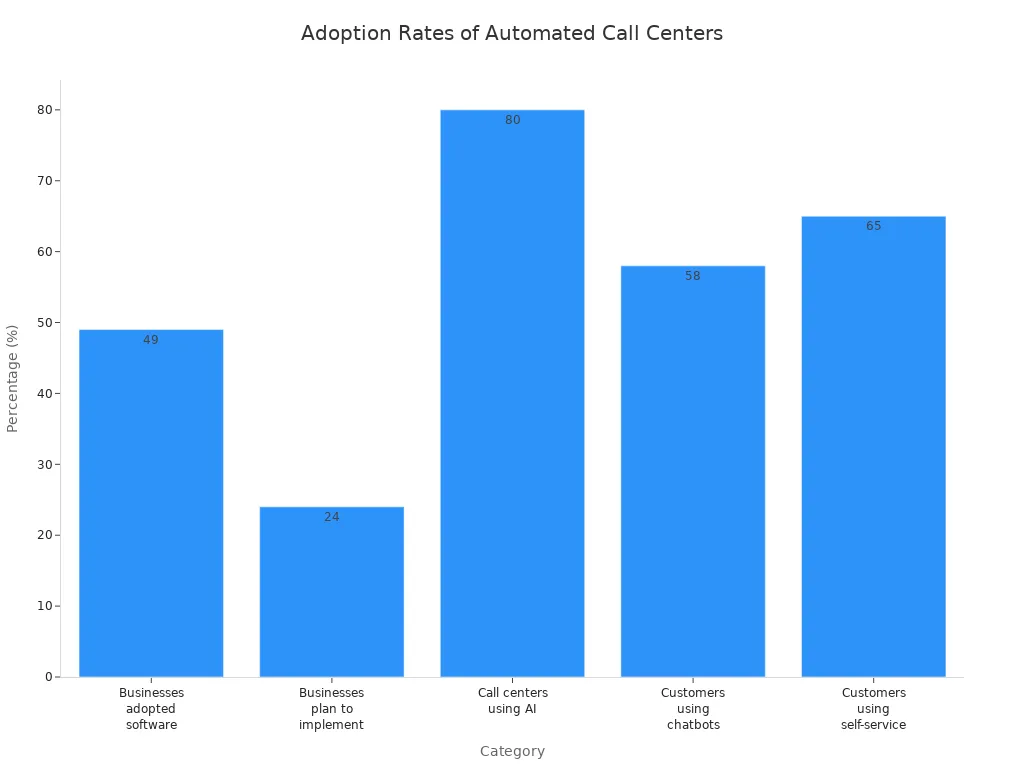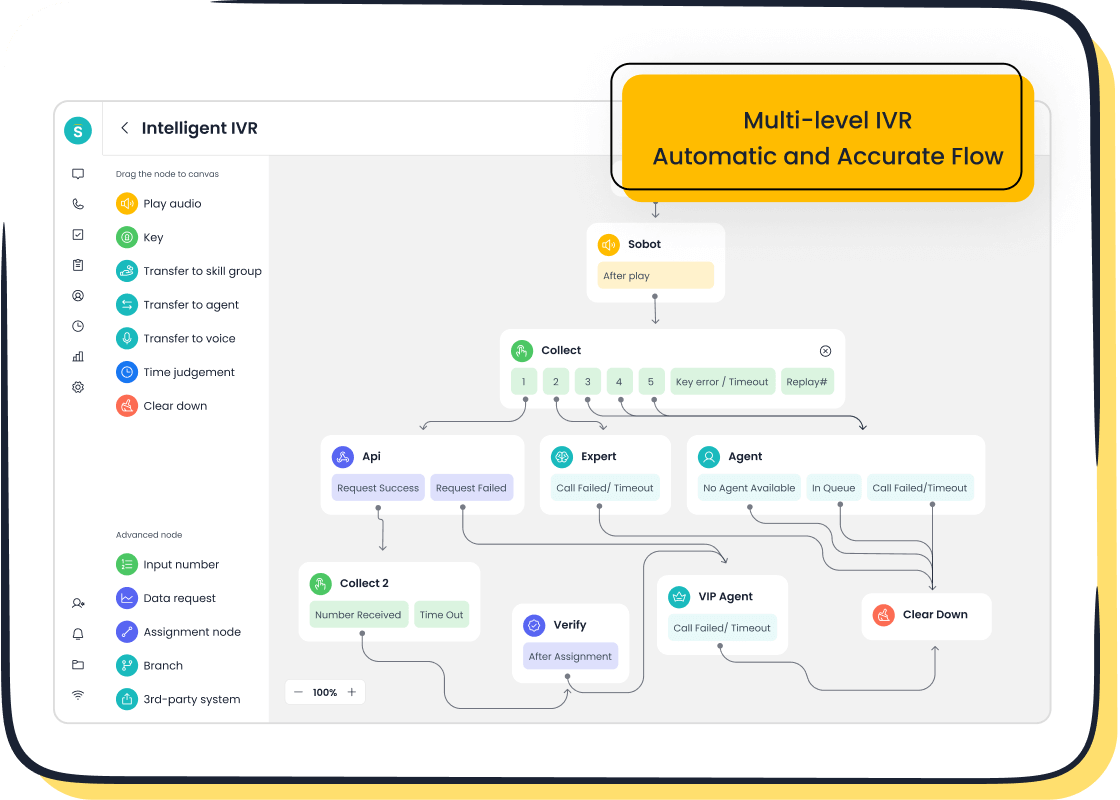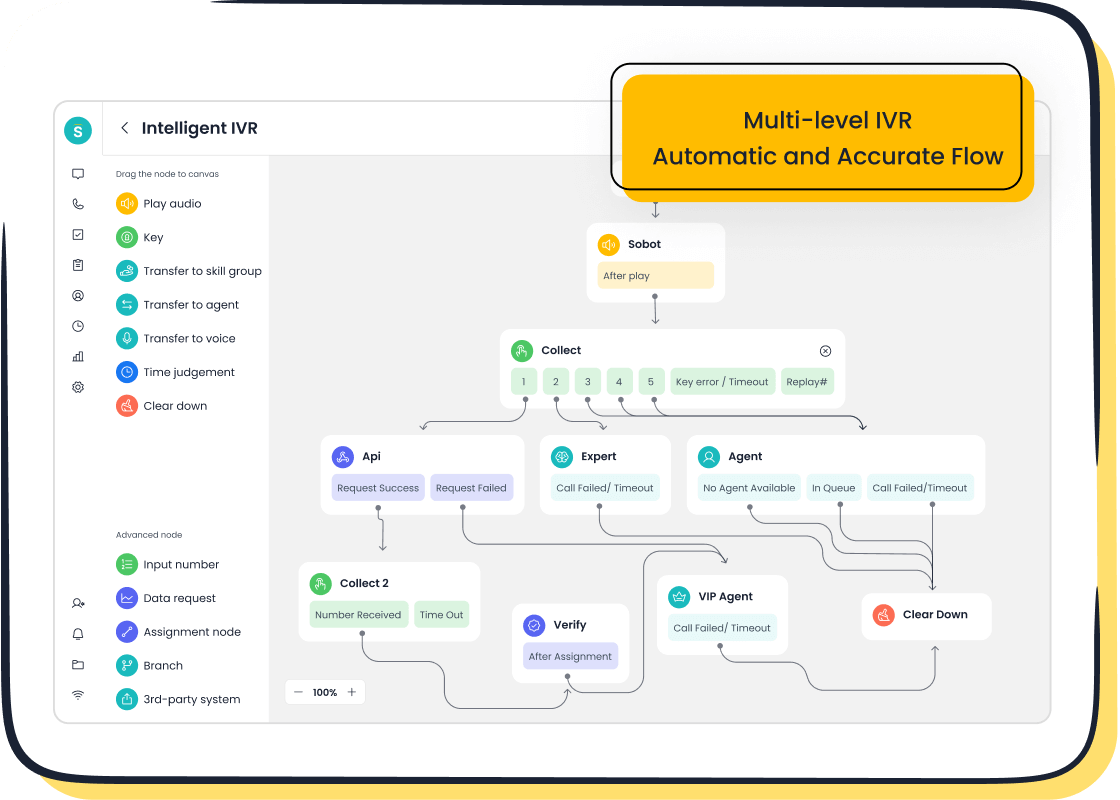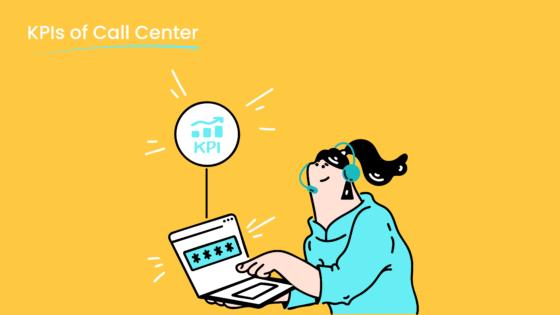Automated Call Center Implementation Checklist for Success

Ready to boost your automated call center results? You need a solid implementation roadmap to get the most out of contact center automation. Almost half of businesses now use automated call center software, and 80% of telecom call centers rely on AI. Check out the adoption rates below:
| Statistic Description | Value/Percentage |
|---|---|
| Businesses that have adopted call center software | 49% |
| Businesses planning to implement call center software in next 2 years | 24% |
| Call centers in telecommunications using AI | 80% |
| AI market value in call centers (2023) | $1.6 billion |
| Expected AI market value in call centers (2027) | Over $4 billion |
| Customers using chatbots | 58% |
| Customers using self-service portals | 65% |

With Sobot AI and the Sobot call center, you can achieve real cost savings and better automated customer service. Use this checklist as your guide for customer service automation success.
Assess Needs
Review Current Operations
You want your contact center automation journey to start strong. Begin by looking at how your current call center works. Ask yourself: Are your agents spending too much time on repetitive tasks? Do customers wait on hold for ages? Many call centers struggle with inefficient processes, like confusing call routing and outdated communication tools. These issues slow down your team and frustrate customers. Data security is also a big concern. You handle sensitive customer information every day, so keeping it safe matters. High call volumes can overwhelm your resources, causing long wait times and unhappy customers. Sobot’s unified workspace and secure cloud platform help you manage these challenges by streamlining workflows and protecting customer data.
Tip: Make a list of your current tools, processes, and pain points. This will help you spot areas where automation can boost efficiency and customer satisfaction.
Set Automation Goals
Now, think about what you want to achieve with automation. Most contact center leaders see automation as a top priority. In fact, 91% say it’s critical, and 72% expect it to cut costs by at least 25% (source). Set clear goals for your automation project. Do you want to improve customer experience, reduce average handle time, or offer more self-service options? Use industry benchmarks to guide you:
| KPI | Benchmark / Standard | Notes |
|---|---|---|
| First Call Resolution | 70-79% good; 80%+ world-class | Higher rates mean better customer satisfaction |
| Customer Satisfaction | 75-84% good; 85%+ world-class | Based on post-call surveys |
| Average Handle Time | 7-10 minutes | Shorter times mean greater efficiency |
| Service Level | 80% calls answered within 20 seconds | Fast answers improve customer experience |
Sobot’s AI-powered Voicebot and self-service features help you reach these goals by automating routine inquiries and freeing up agents for complex issues.
Identify Pain Points
Pinpoint what’s holding your team back. Common pain points include long hold times, poor issue resolution, and high agent turnover. Remote agents often struggle with collaboration and limited access to resources. Outdated technology can slow down your process and hurt customer experience. Bottlenecks during peak call volumes lead to dropped calls and frustrated customers. Integration issues between different systems also cause errors and increase costs. Sobot’s omnichannel solution tackles these problems by connecting all your channels, automating repetitive tasks, and providing real-time analytics for better decision-making.
Note: When you identify your pain points, you can choose the right automation tools to solve them and improve efficiency, customer satisfaction, and overall customer experience.
Find Automation Opportunities
Map Customer Journeys
You want to know where automation will make the biggest difference. Start by mapping your customer journeys. This means looking at every step a customer takes when they reach out for help. Use an omnichannel contact center like Sobot to bring together all your channels—chat, phone, email, and social media. This way, you see the full picture of each customer interaction.
- List every channel your customers use to contact support.
- Map out each touchpoint, from first contact to resolution.
- Watch for places where customers get stuck or drop off.
- Use AI-powered tools to spot patterns, flag risks, and highlight key moments in real time.
- Pinpoint where information gets lost as customers move between channels.
Don’t guess—use real data from your CRM, web analytics, and customer feedback. Create customer personas to see how different people move through your system. When you update your journey maps often, you keep up with changing needs and trends. This helps you find the best spots for automation and self-service.
Tip: Give your agents tools that show the whole customer journey. This boosts efficiency and helps agents deliver a better customer experience.
Prioritize Tasks for Automation
Not every task needs automation right away. Focus on the ones that will save the most time and improve customer experience. Start with high-volume, repetitive jobs like answering common questions or collecting customer data. Sobot’s AI-powered Voicebot and self-service portal handle these tasks well, freeing your agents for more complex issues.
- Target tasks that cut down on handling times and boost satisfaction.
- Pick automation tools that work with your current systems, like CRM and ticketing.
- Choose solutions that scale as your call center grows.
- Make sure both agents and supervisors find the tools easy to use.
- Automate call scheduling, virtual queuing, and routine data entry.
Many call centers use automation for quality management, lead generation, and business intelligence. For example, real-time speech analytics can alert supervisors to problems, while chatbots can engage website visitors and schedule calls. These steps improve efficiency and make customer self-service options more effective.
Evaluate ROI
You want to know if your investment in automation pays off. Look at both cost savings and revenue growth. Here’s a real-world example from AceRetail, a mid-sized company:
| Category | Amount (USD) |
|---|---|
| Initial Implementation Costs | $220,000 |
| Annual Operational Costs | $130,000 |
| Annual Revenue Increase | $550,000 |
| Annual Cost Savings | $52,000 |
| Total Annual Revenue from Investment | $602,000 |
| ROI Year 1 | 72% |
| ROI Year 2 and Beyond | 363% |
Automation can reduce manual process costs by up to 30% (McKinsey). Improving first call resolution by just 1% can lower operating costs by 1%. Sobot’s customer interaction automation and self-service features help you reach these numbers by making your team more efficient and your customers happier.
Note: When you track ROI, include gains from better customer experience, higher sales conversion, and lower agent workload. Automation is not just about saving money—it’s about building a smarter, more responsive call center.
Choose Tools and Technologies

Select Sobot Voice/Call Center

When you want to choose the right tools for your automated system, Sobot Voice/Call Center stands out. You get a platform with 99.99% uptime, so your service stays stable and reliable. The intelligent IVR lets you customize greetings and route calls quickly. You can manage both inbound and outbound calls with smart routing and call monitoring. The unified workspace helps agents work faster, improving reception efficiency by up to 48%. Sobot’s AI-powered voicebot handles customer interaction automation, giving automated responses and passing complex cases to human agents. You also get global phone numbers from over 100 countries, so you can reach customers anywhere. Sobot’s mobile app lets agents work on the go, and real-time analytics help you track hundreds of metrics. Strong data security keeps sensitive information safe, meeting international standards.
Tip: Sobot’s flexible SaaS model means you only pay for the customer service tools you need. This helps you save money and scale as your business grows.
Compare Automation Solutions
You need to compare automation solutions before you choose the right tools. Look for platforms that use AI to handle repetitive tasks, like chatbots answering common questions. Chatbots and advanced automation tools boost agent productivity and let your team focus on complex issues. Make sure the solution supports omnichannel communication, so customers can reach you by phone, chat, email, or social media. Integration with CRM and other systems is key for personalized service. Check if the platform offers real-time analytics, automated reporting, and quality assurance features. Security matters too—look for strong encryption and compliance with laws like GDPR and HIPAA. The best solutions balance automation with human touch, so customers always get the help they need.
| Factor Category | Key Considerations & Examples |
|---|---|
| Customization Options | IVR menus, chatbot scripting, API integration, branding customization |
| AI and Automation | Speech recognition, NLP, analytics, integration with other AI services |
| Security and Compliance | Data encryption, GDPR/HIPAA compliance, access control, regular audits |
| Provider Reputation & Support | Market experience, customer reviews, 24/7 support, SLA |
| Integration Capabilities | CRM, ERP, helpdesk, workforce management integration |
| Omnichannel Support | Calls, chat, social media, email |
| Real-Time Analytics | Monitoring KPIs, call volumes, agent efficiency |
| Scalability & Balance | Growth support, clear escalation paths |
Ensure Integration
You want your automation tools to work smoothly with your existing systems. Start by mapping out your processes and setting clear goals. Involve your IT team early and test everything before a full rollout. Sobot Voice/Call Center makes integration easy with fast connections to CRM and technology management systems. Regular training helps agents use new tools well. Keep data secure with strong encryption and access controls. Always update your technology to stay competitive. Use analytics to monitor performance and improve customer interactions. Balance automation with human support, so your team can handle complex cases and keep customers happy.
Note: Seamless integration and strong security protect your business and build customer trust.
Plan Implementation
You have your goals and tools ready. Now, it’s time to plan your implementation so you can launch your automated call center with confidence. A strong plan helps you avoid surprises and keeps your team on track.
Create a Phased Rollout
Rolling out automation all at once can feel overwhelming. Instead, break the implementation into smaller steps. Here’s a simple way to approach it:
- Start with a pilot group or one department. This lets you test the process in a controlled setting.
- Focus on features that deliver quick wins, like automating repetitive tasks first.
- Expand the rollout in phases. Each phase should build on the last, making the system easier to adopt.
- Monitor key metrics such as call routing accuracy and customer satisfaction after each phase.
- Use feedback from each stage to improve the next one.
- Celebrate small wins to keep your team motivated.
Tip: A phased implementation helps you spot issues early and gives your team time to adapt. This approach increases adoption rates and reduces risk.
Assign Roles
You need the right people in the right roles to implement contact center automation smoothly. Here’s a table showing who does what during the process:
| Role | What They Do |
|---|---|
| Call Center Manager | Oversees the whole implementation, sets goals, and manages resources. |
| Team Leader/Supervisor | Coaches agents, monitors performance, and supports daily operations. |
| Customer Service Agent | Handles calls and adapts to new automated systems. |
| Quality Assurance Specialist | Checks call quality and helps develop best practices for automation. |
| Workforce Management Analyst | Schedules staff and analyzes call data to match automation needs. |
| Training Coordinator | Trains agents on new tools and process changes. |
| IT Support Specialist | Keeps technology running and solves technical issues. |
| Sales Representative | Engages customers and supports sales through the automated system. |
Everyone plays a part in the implementation. Make sure each person knows their responsibilities and gets the training they need.
Prepare Infrastructure
Your technology must support the new automated system. Here’s what you should have in place:
- Advanced AI tools like speech recognition and natural language processing.
- Omnichannel communication so customers can reach you by phone, chat, or email.
- Integration with CRM and other business systems for a smooth process.
- Analytics to track performance and spot areas for improvement.
- Strong security, including voice biometrics and data encryption.
- Unified agent desktops that bring all tools together for easy access.
Sobot’s platform checks all these boxes. You get a unified workspace, smart IVR, and secure cloud infrastructure. This makes the implementation process easier and helps you deliver a better customer experience.
Note: Preparing your infrastructure before you implement contact center automation saves time and prevents problems down the road.
Train and Launch

Staff Training
You want your team to feel confident using your new automated call center. Training works best when you set clear goals and keep everyone engaged. Start by sharing key performance indicators like customer satisfaction scores and call resolution rates. Use hands-on practice in sandbox environments so agents can try out chatbot features and self-service tools without pressure. Microlearning helps agents learn in short bursts, which fits busy schedules. Role-playing and scenario-based training prepare your team for tough customer calls. In-app guidance and digital adoption platforms give agents help right when they need it. Gamification, like earning points or badges, makes training fun and keeps everyone motivated.
Tip: Ask for feedback during training sessions. Adjust your training based on what agents say and how they perform. This keeps your automated customer service sharp and relevant.
Pilot Automated Call Center
Before you launch your automated call center for everyone, run a pilot. Pick a small group or department to test the system. Set clear business goals for the pilot, like improving first call resolution or reducing average handle time. Make sure your data is accurate and reliable. Use explainable AI models so agents trust the new technology. Build hybrid teams with both operations and data experts to oversee the pilot. Test chatbot and self-service portal features in a controlled setting. Watch how agents and customers react, then refine your approach.
Note: Piloting helps you spot problems early and build trust in your automated customer service tools.
Full Rollout
When you’re ready for a full rollout, track key metrics to measure success. Focus on first call resolution, customer satisfaction score, and net promoter score. These numbers show how well your automated call center works for customers. Monitor average handle time, call volume, and agent utilization to see how efficient your team is. Keep an eye on self-service rates and cost per call to understand financial impact. Sobot’s analytics dashboard makes it easy to follow these metrics in real time. Use feedback from agents and customers to keep improving your system.
| Metric Type | Examples |
|---|---|
| Customer Experience | FCR, CSAT, NPS, CES, ASA |
| Efficiency | AHT, Call Volume, Service Level |
| Agent Performance | Utilization Rate, Turnover, Adherence |
| Financial | Cost Per Call, Churn Rate, Self-Service |
Celebrate wins and share results with your team. Continuous improvement keeps your automated customer service running smoothly.
Monitor and Optimize
Track Performance
You want your automated call center to keep getting better. Start by tracking the right performance indicators. Sobot gives you real-time analytics and AI-driven insights, so you can see what’s working and what needs attention. Here are some key metrics you should watch:
- Average Handle Time: Shows how long agents spend on each call. Balance speed with quality.
- First Contact Resolution: Measures how often you solve customer issues on the first try. High rates mean a better customer experience.
- Call Routing Accuracy: Checks if calls reach the right agent or department.
- Automated Contact Resolution Rate: Tells you how many customer questions get solved by automation without human help.
- Customer Satisfaction Score (CSAT): Shows how happy customers are after using your automated services.
Sobot’s dashboard lets you monitor these numbers across all channels. You can spot trends, fix problems fast, and improve response times for every customer.
Gather Feedback
Listening to your customers and agents helps you make smart changes. Use surveys and feedback tools to collect their thoughts. Here’s a quick look at some popular options:
| Tool Name | Key Features |
|---|---|
| SurveyMonkey | Easy surveys, strong data analysis |
| Qualtrics XM | Custom dashboards, deep analytics |
| Medallia | Real-time feedback, advanced insights |
| Insight7 | AI feedback from calls, surveys, and reviews |
You can automate feedback collection with these tools. Sobot also supports feedback through its omnichannel platform, so you get input from every customer touchpoint. Real-time feedback helps you spot issues early and keep customer satisfaction high.
Tip: Use both customer and agent feedback to fine-tune your automation. This leads to an enhanced customer experience and higher efficiency.
Continuous Improvement
Never stop improving your call center. Set up regular training for your agents, even after you launch automation. Review your performance data often. Use Sobot’s analytics to find areas where you can do better. Try new features, update your scripts, and keep learning about industry trends.
Here’s a simple plan for ongoing success:
- Analyze your call center data every week.
- Train your team on new tools and best practices.
- Test new automation features and measure results.
- Gather feedback and act on it quickly.
- Benchmark your performance against industry standards.
With Sobot, you can handle up to 70% of routine queries using AI, which frees your agents to focus on complex cases. This approach boosts customer satisfaction and delivers a better customer experience for everyone.
You can set your team up for success with a structured checklist for contact center automation. Many companies see faster resolutions and higher customer satisfaction when they follow clear steps, like mapping use cases and tracking results. Sobot’s customer service automation platform gives you reliable tools, real-time analytics, and proven support—just like top brands enjoy. Print or download this checklist and keep it handy. Start your customer service automation journey today and watch your results improve every week!
| Step | Benefit |
|---|---|
| Use a checklist | 25% faster resolutions |
| Monitor compliance | Fewer errors and failures |
| Choose Sobot | Reliable, scalable automation |
FAQ
What is an automated call center and how does it work?
An automated call center uses technology like AI, IVR, and chatbots to handle customer calls and tasks. You can answer common questions, route calls, and collect data without needing a live agent every time. Sobot’s platform makes this process smooth and reliable.
How can Sobot improve my customer service automation?
Sobot gives you tools like AI-powered Voicebot, smart IVR, and a unified workspace. You can automate up to 70% of routine queries, cut costs, and boost customer satisfaction. Many companies see a 25% faster resolution rate after switching to Sobot’s automated call center.
Is it hard to integrate Sobot with my current systems?
No, Sobot makes integration simple. You can connect Sobot’s automated call center with your CRM, ticketing, and other business tools. The process is fast and secure. Most businesses finish setup in days, not weeks.
Tip: Always test your integration with a small group first. This helps you catch any issues early.
What results can I expect from customer service automation?
You can expect shorter wait times, higher first call resolution, and happier customers. For example, Agilent saw a 6x increase in efficiency and a 25% cost reduction after using Sobot’s automated call center (see case study).
How do I measure success after implementing an automated call center?
Track metrics like first contact resolution, customer satisfaction (CSAT), and average handle time. Sobot’s analytics dashboard shows these numbers in real time. Here’s a quick table:
| Metric | Why It Matters |
|---|---|
| FCR | Solves issues faster |
| CSAT | Shows customer happiness |
| AHT | Measures efficiency |
See Also
Understanding The Efficient Operation Of Call Center Automation
Comprehensive Guide To Software For Call Center Quality Assurance
Top Strategies For Effective Call Center Quality Management
Step-By-Step Process To Deploy Omnichannel Contact Center Solutions
Essential Guide To Quality Management System Principles In Call Centers
